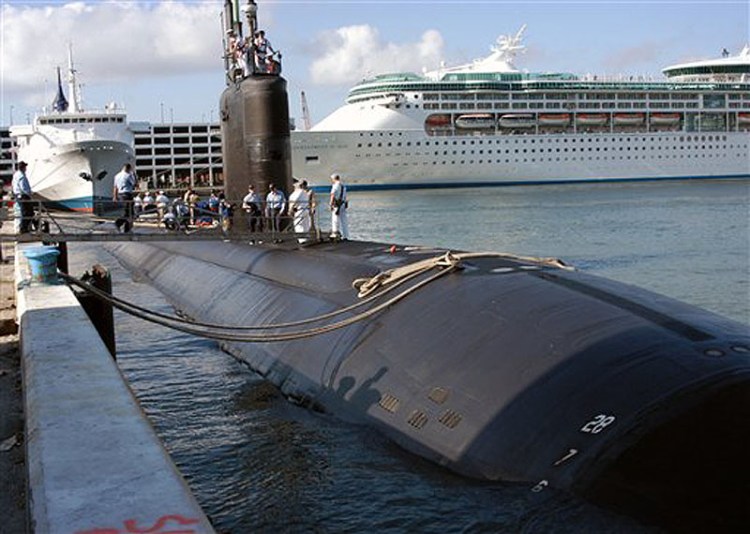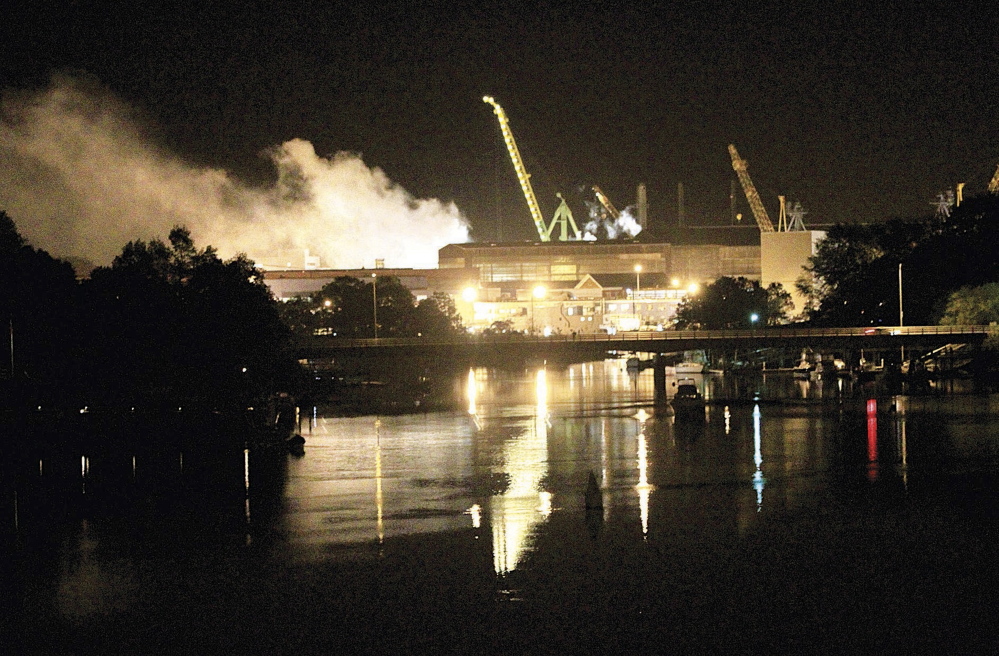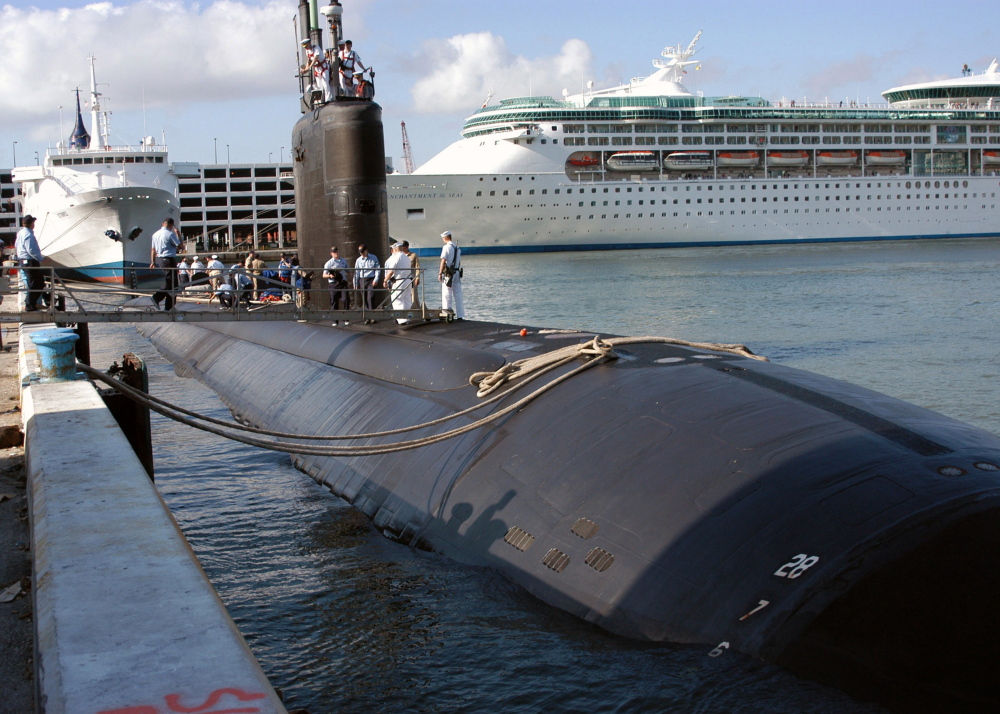Complacency about safety during shipyard repairs and dependency on firefighters who didn’t specialize in fires aboard ships contributed to the severity of a blaze that crippled a $900 million nuclear submarine, Navy investigators concluded.
Investigators also said confusion at the start of the May 2012 fire at the Portsmouth Naval Shipyard squandered precious minutes as the fire grew aboard the USS Miami and that there were two hour-long periods in which no water was put on the flames.
The conclusions, some of which were disputed by firefighters, were included in more than 100 pages of documents obtained by The Associated Press under a Freedom of Information Act request.
It took 12 hours and the efforts of more than 100 firefighters to save the Groton, Connecticut-based Miami after a worker who wanted to go home early set a small fire that quickly spread. Though the sub was saved, the Navy ultimately decided to scrap it after the repair bill hit $700 million.
The fire severely damaged living quarters, the command and control center and a torpedo room, but it did not reach the nuclear propulsion components. Seven people were hurt dousing the flames.
“Complacency had set in, based on the infrequency of shipyard fires and relative success of fire prevention measures,” the report said. “Also, there was an assumption that the proximity to far more assets, especially federal firefighters, reduced the likelihood of a fire not being quickly contained. This organizational reluctance to prepare for a fire of this scale should serve as a wake-up call – large fires can and do happen in industrial environments.”
The Navy launched a series of investigations that led to recommendations, including the installation of temporary automatic fire detection systems while vessels are being repaired or overhauled. It issued a new fire safety and prevention manual.
The Navy says it has learned lessons from the Miami fire and shared them across the fleet.
“We will continue to apply best response practices into shipyard fire emergency plans,” Navy spokesman Lt. Timothy Hawkins said Thursday.
A report by U.S. Fleet Forces Command indicated just how dire the situation became aboard the Los Angeles-class submarine, which was undergoing a 20-month overhaul in Kittery, Maine: At one point, officials discussed abandoning their firefighting efforts and flooding the dry dock when it appeared the submarine was going to be lost.
Instead, firefighters battling extreme heat, cramped compartments and near-zero visibility eventually beat back the flames.
Investigators said shipyard firefighters were unfamiliar with the submarine’s layout and that there was no requirement for certification to battle a fire in a shipboard environment — or even conduct a walk-through to familiarize themselves with the sub.
But Brian Tapley, who was the shipyard fire chief at the time, disputed any suggestion that the firefighters were unfamiliar with Miami. Firefighters conducted monthly walk-throughs, practiced dragging hoses through submarines and never flunked a drill, he said.
Tapley also disputed a Navy assertion that firefighters didn’t ask about the submarine’s battery, even though fighting a battery fire with water can result in an explosion. The sub’s commanding officer confirmed the batteries were removed, he said.
The report noted that holes cut in the submarine during repairs fed oxygen to the fire, turning the metal hull into a furnace.
“They climbed into the belly of an inferno,” said Paul O’Connor, president of the Metal Trades Council, a union at the shipyard. “Every one of them was a hero.”
While the report questioned the readiness by firefighters, the Navy also said it was to blame for failing to incorporate lessons learned from past fires into training and for not making the roles for Navy authorities clear. At one point, an order was given to turn back the firefighters dispatched from the Groton submarine base, who knew how to fight this kind of a fire. That order was overruled.
The Fleet Forces report included 99 recommendations – virtually all of which were redacted because they weren’t final decisions, Hawkins said. The Navy experiences a fire of comparable magnitude to the Miami blaze about every five years, and without corrective action, that pattern would continue, investigators said.
U.S. Sen. Richard Blumenthal of Connecticut, a member of the Senate Armed Services Committee, said he was disappointed the recommendations weren’t made public, and said he plans to ask the Navy for them. He wants to hold a congressional hearing on firefighting techniques and training to determine whether Congress should allocate additional funding.
“The report documents a very compelling need for better training and more expert firefighters that can help stop such catastrophic fires on submarines,” he said.
The recommendations apply to ships that are being repaired or overhauled. The report notes that the vessels are more vulnerable in that setting because damage-control equipment is removed or inoperable; most of the crew is away; and temporary fire-control equipment is less familiar to crew.
McDermott reported from Providence, Rhode Island.
Send questions/comments to the editors.





Success. Please wait for the page to reload. If the page does not reload within 5 seconds, please refresh the page.
Enter your email and password to access comments.
Hi, to comment on stories you must . This profile is in addition to your subscription and website login.
Already have a commenting profile? .
Invalid username/password.
Please check your email to confirm and complete your registration.
Only subscribers are eligible to post comments. Please subscribe or login first for digital access. Here’s why.
Use the form below to reset your password. When you've submitted your account email, we will send an email with a reset code.